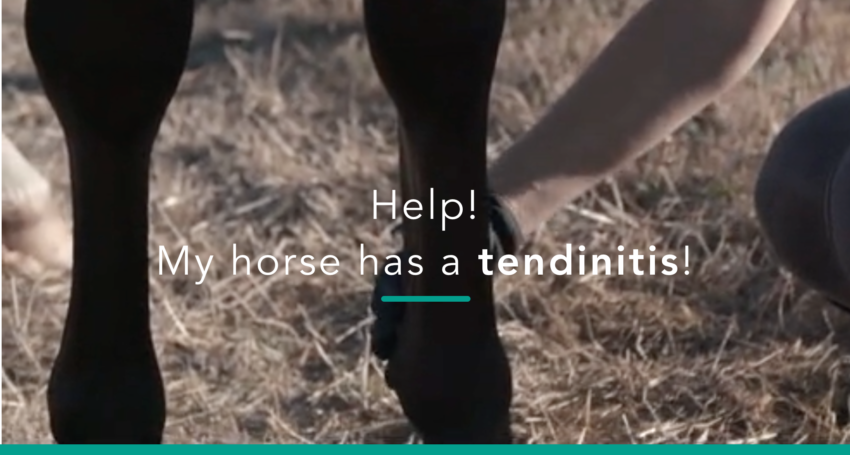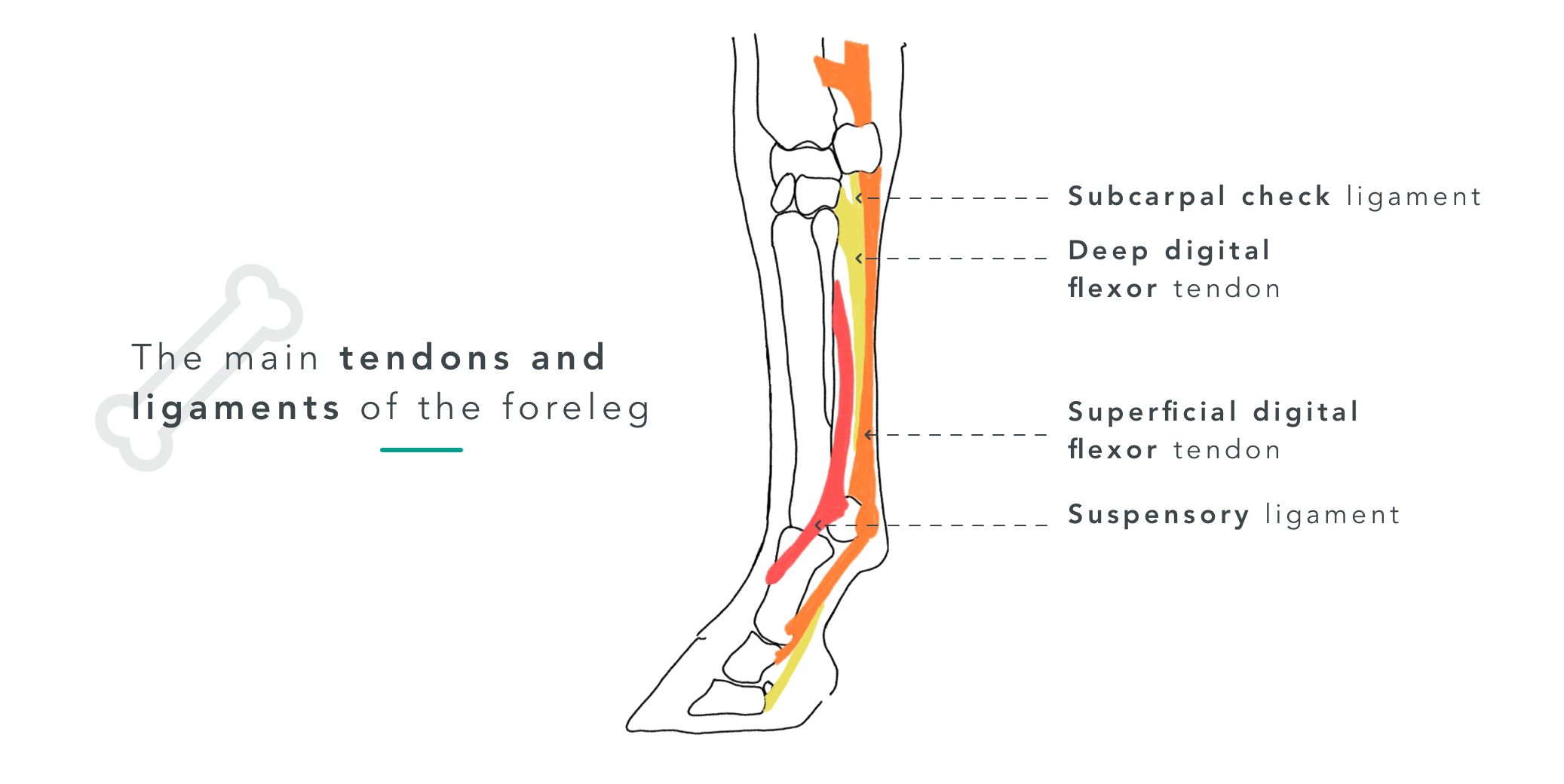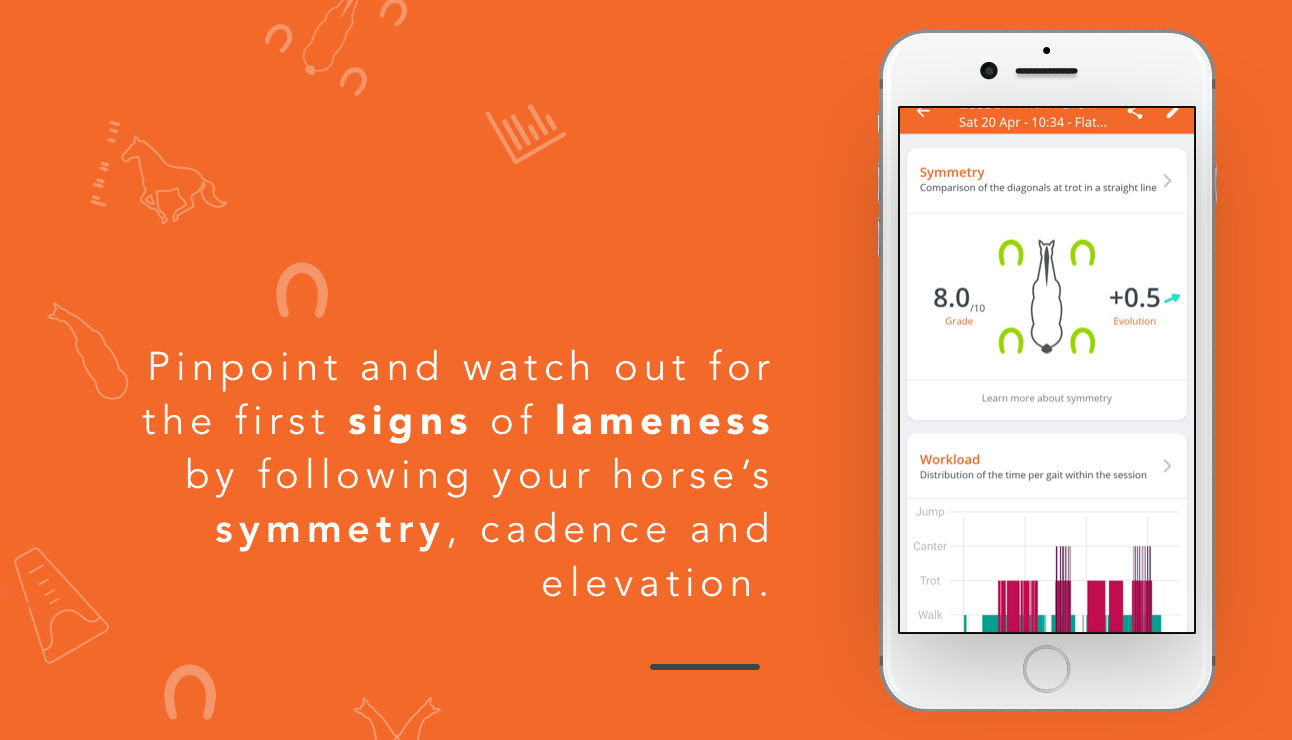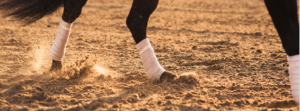
My Horse has Tendinitis, how bad is it?
Ouch, tendinitis hurts the horse and is scary for the rider! We’re never really sure how it happens. We wonder if we could have done anything to prevent it. Especially since it’s something that can get worse slowly, without you noticing until one day when “Ah, my horse is lame!”.
In this article, I’m going to answer a few questions about this: which tendons are affected? Which signs can alert you? What can you do to help your horse recover?
Table des matières
Let’s start with a bit of anatomy
You should be used to it by now, at Equisense we (really) like anatomy. Not just because we like pretty drawings (it’s still part of the reason) but because it explains a lot!
In this article, we’ll speak of 3 main tendons (prolongations of a muscle towards a bone) and ligaments (linking two bones between each other):
- The superficial digital flexor tendon. It’s the one you can feel right under the skin, at the back of the cannon bone.
- The deep digital flexor tendon. It’s covered by the superficial digital flexor tendon and it is attached to the carpus (knee bone) by the subcarpal check ligament and ends in the foot.
- The suspensory ligament. It divides in 2 branches halfway up the cannon bone.
Vous pouvez sentir ces 3 structures anatomiques très facilement sur votre cheval. Si, si, je vous assure: essayez, vous verrez !
The tendon is mature early on (when the horse is 2-years-old). This means it won’t adapt to effort, like a muscle will change according to how much it works [1]. It has (thankfully!) a very high resistance to tension (until 2000kg) [1] but if this resistance is overwhelmed, the tendon fibers get damaged.
The particularities of the horse’s legs
Have you noticed that, compared to us, there’s almost no muscles in the horse’s legs? There is however a lot of tendons and ligaments. This is because the horse’s body is used to running away. The tendons of its muscles are voluminous and have a particularity: they have very powerful “accessory ligaments” allowing the movements to be automatic [2]. The energy economy provided by these ligaments increases the horse’s speed. They are very elastic, which allows them to in fact replace the muscles, and be lighter than them.
This mechanism is a bother in the case of a tendinitis because with the automatisation, the horse can’t control how much strength it puts on its tendons [1]. Furthermore, with the horse’s body weight being what it is, the strain is important when it moves, especially when it runs. It’s when these strains become too important that tendon injuries appear.
What should alarm you?
Daily monitoring
Firstly, you need to know that tendinitis are progressive injuries which will worsen as time passes. They often have what we call a subclinical phase. To put it shortly, it’s a phase in which the symptoms are not yet noticeable, they are subtle. It’s in cases like this that you can use new technology (like the symmetry indicator on the Equisense Motion 😉) to get more awareness on your horse’s well being. This can help you detect a tendinitis at an early stage, before the injury gets worse. If the symptoms increase, we reach an acute or clinical phase.
Distorsions
You can be alerted by a deformation of the tendon region, associated or not to heat and/or pain when you touch it. That’s why you should touch this part of your horse often! Before you ride and after your ride, before you turn your horse in. Your hand (associated to your brain of course!) will get used to the “norm” for your horse and you’ll feel the anomaly the day it happens. If you feel something odd, don’t wait up and immediately call your vet, even if your horse isn’t lame. [3]
The much dreaded lameness
You can also be alerted by a lameness when the injury isn’t physically visible. It’s often the case when the injury is on the suspensory ligament or the deep digital flexor tendon. Often, the lameness is sporadic (and you might be wondering if you wouldn’t be dreaming!). Even if there is no rule for lameness, it often appears after a warm up and is accentuated by a deep terrain. [3]
Be careful, there’s a “trap” case: 😮 it’s possible that your horse presents a distortion around the tendons on a foreleg and is lame on the other foreleg (the one without a distortion). In this case, your horse can suffer from arthropathy on the lame leg (the arthritis pain causes the lameness) and the chronic overload on the opposite leg causes the tendinitis (the horse relieves the painful member, creating an injury on the other side). [1]
But how did this happen?
We have a tendency to blame ourselves and wonder if we could have done anything to prevent this tendinitis from happening. Keep in mind that there are 3 possible causes for tendinitis [1]:
- Strain damage: it appears on horses working a lot. There is then a mismatch between the horse’s level of exercise and the abilities of the tendon to distort during the effort. This damage heal when you leave the horse to rest.
- Degenerative damage: it mostly happens in older horses. The degenerative process can’t be stopped and the horse won’t heal. The tendon will fibrose eventually (they lose elasticity). Leaving the horse to rest will only help for pain relief and won’t heal it.
- Limb conformation faults: some horses have poor limb conformation, enabling chronic tendinitis when a leg is overloaded.
Let’s keep in mind that tendon injuries are frequent in sport horses. However, their origin depends on the horse’s specific sport and how intense its activity is. For instance, an eventing horse is more likely to get injuries on the suspensory ligament or the superficial digital flexor tendon, a showjumper on the superficial digital flexor tendon or the subcarpal check ligament, and a leisure horse on the deep digital flexor tendon.
Learn more: How to improve my horse’s physical condition?
So, what can you do?
I won’t get into too much detail on how to treat tendinitis because it could be a whole article by itself as there are so many possible treatments. Let’s just say that treatment is often long and hard. It needs to be adjusted to every case since every horse has its own personal injuries, its own individual healing factor and its own work activity.
A few notes, though:
Rest and recovery
The most important thing to treat a tendinitis is of course rest (or at least a recovery with a large decrease in activity according to the situation). How long your horse should rest? That’s a controversial matter. Studies show that an adjusted recovery program allows better results than resting in a field does. As a matter of fact, it could also decrease the risks of relapse [4,5]. That’s something you have to talk to your vet about.
Let’s still keep in mind that in any case, you have watch out for your horse gaining weight during its recovery! This could cause issues when it gets back to work.
Learn more: Cereal free feeds: good idea or not?
Ground management
Managing the grounds your horse will work on can also help your horse since it affects both the treatment and the prevention of tendinitis.
Overall, it’s important to note that if the toe (the tip of the hoof) can sink more into the ground, the deep digital flexor tendon and the subcarpal check ligament are less stressed.
Contrariwise, if the toe sinks less into the ground, the superficial digital flexor tendon and the suspensory ligament are less stressed.
In the case of a deep digital flexor tendon or a subcarpal check ligament tendinitis, it’s better to avoid harder grounds. Contrariwise, for a superficial digital flexor tendon or a suspensory ligament tendinitis, it’s better to avoid softer grounds.
Unfortunately, it isn’t always easy to apply this “at home”, but you can try to watch out where you go on shows (if your horse is healed of course).
Bandages management
Stable bandages will restrict the engorgement: they are to be used only on horses whose legs get congested after work and have no impact on tendinitis prevention.
Exercise wraps, on the other hand, stop the vibrations in the horse’s leg. The vibrations enable the vascularization of the leg (so exercise wraps hinder the vascularization). It’s a bit tricky, but exercise wraps are suitable in an early stage tendinitis (because vascularization is bad when the leg is healing at this stage) but ill advised for old chronic injuries (which require a good vascularization).
Lastly, let’s say that our treatment of choice depends on the injury and its chronology. We won’t do the same treatment for a subclinical tendinitis or an acute tendinitis or old injuries. That’s why it’s important to have the vet come: with the echography, they’ll be able to provide the right treatment.
To conclude
Tendinitis are common but complex pathologies, and it’s not always easy to heal them. The treatment is often disappointing and the pronostic depends on so many factors (origin of the injury, activity, recovery time, etc). “Better safe than sorry” is more than appropriate here: I will only advise you to pay attention to your horse’s locomotion and its legs every day. Equisense Motion can be a precious tool to monitor this evolution.
See you soon for another article,
Marine Slove
Veterinary.
Bibliography:



